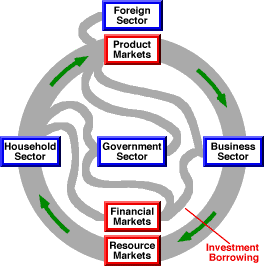
|
|
AGGREGATE EXPENDITURE EQUATION: An equation indicating that aggregate expenditures (AE) are the sum of consumption expenditures (C), investment expenditures (I), government purchases (G), and net exports (X-M), stated as: AE = C + I + G + (X-M). This equation surfaces in the Keynesian economic income-expenditure model in the form of the aggregate expenditures line. However, it's also central throughout the study of macroeconomics, including aggregate demand and the measurement of gross domestic product.
Visit the GLOSS*arama
|
|


|

|
                           INVESTMENT BORROWING: The acquisition of funds through the financial markets by the business sector which are used to finance investment expenditures on capital goods. In terms of the simple circular flow model, this is one of two basic demands for household saving diverted into financial markets. The other is government borrowing. Investment borrowing is a prime source of funds used by the business sector to pay for investment expenditures on capital goods. Other sources of financing come from internal savings of revenue that the business sector receives from the sale of production, especially retained earnings and capital consumption adjustment.Working the Financial MarketsThe business sector obtains funds used for investment through the financial markets. The function of financial markets is to divert household sector income to other expenditures, especially investment expenditures and government purchases. They accomplish this by trading legal claims.- Savers and Buyers: On one side of the financial markets, savers in the household sector buy legal claims and in so doing divert income to the financial markets. They give up income in exchange for the legal claims to the ownership of physical assets or to future repayment of income.
- Borrowers and Sellers: On the other side, borrowers in the business and government sectors sell legal claims and in so doing obtain the income from the financial markets that they use to undertake expenditures. The borrowers give up legal claims in exchange for income.
Accumulating IncomeThe business sector borrows income through the financial markets to accumulate income used to finance expensive capital investment. Investment borrowing allows the business sector access to larger amounts of funds than that obtained from current revenue alone. Suppose, for example, that OmniConglomerate, Inc. wants to finance the construction of a new $100 million factory. It can make this expenditure outright if it has $100 million of extra funds laying around. However, if such funds are not available, it can sell legal claims through the financial markets by issuing corporate bonds, selling extra corporate stock, or signing a loan agreement with a bank. While this $100 million could come from a single member of the household sector, in all likelihood it is obtained from thousands or even millions of individual savers. Suppose that OmniConglomerate obtains the $100 million through a bank loan from OmniBank. OmniBank has $100 million to lend only because it accumulates small amounts (say $100) from a large number of customers (say 1 million). Each OmniBank customer diverts a little income away from consumption and into the financial markets, which OmniBank combines into the $100 million loan to OmniConglomerate. The Circular Flow| The Circular Flow |  |
Investment borrowing by the business sector can be illustrated with the circular flow model. The circular flow captures the continuous movement of production, consumption, income, and factor payments between producers and consumers.A basic representation of the circular flow is displayed to the right. The components of this model are the four macroeconomic sectors--household, business, government and foreign--and the three macroeconomic markets--product, resource, and financial. The household sector at the far left contains the consuming population of the economy. The business sector at the far right includes all of the producers. The government sector is positioned in the middle of the diagram and the foreign sector is at the very top. The product markets near the top of the flow direct production from the business sector to the household sector in exchange for payment flowing in the opposite direction. The resource markets at the bottom of the flow direct factor services from the household sector to the business sector in exchange for payment flowing in the opposite direction. The financial markets located just above the resource markets divert saving from the household sector to business and government borrowing. The circular flow indicates that the income used by the household sector to purchase goods through the product markets is obtained by selling factor services through the resource markets. It also indicates that the revenue used by the business sector to pay for factor services obtained through the resource markets is generated by selling goods through the product markets. Investment borrowing is the flow between the financial markets and the business sector. The business sector obtains income used for investment expenditures from the saving diverted into the financial markets from the household sector.

Recommended Citation:INVESTMENT BORROWING, AmosWEB Encyclonomic WEB*pedia, http://www.AmosWEB.com, AmosWEB LLC, 2000-2024. [Accessed: April 28, 2024].
Check Out These Related Terms... | | | | | | | | | |
Or For A Little Background... | | | | |
And For Further Study... | | | | | | | | | |
Search Again?
Back to the WEB*pedia
|



|

|
GREEN LOGIGUIN
[What's This?]
Today, you are likely to spend a great deal of time waiting for visits from door-to-door solicitors seeking to buy either a combination CD player, clock radio, and telephone (with answering machine) or a revolving spice rack. Be on the lookout for slow moving vehicles with darkened windows.
Your Complete Scope
This isn't me! What am I?
|

|
|
North Carolina supplied all the domestic gold coined for currency by the U.S. Mint in Philadelphia until 1828.
|

|
|
"The roots of education are bitter, but the fruit is sweet." -- Aristotle
|

|
ADV PMT
Advance Payment
|

|
|
Tell us what you think about AmosWEB. Like what you see? Have suggestions for improvements? Let us know. Click the User Feedback link.
User Feedback
|


|


